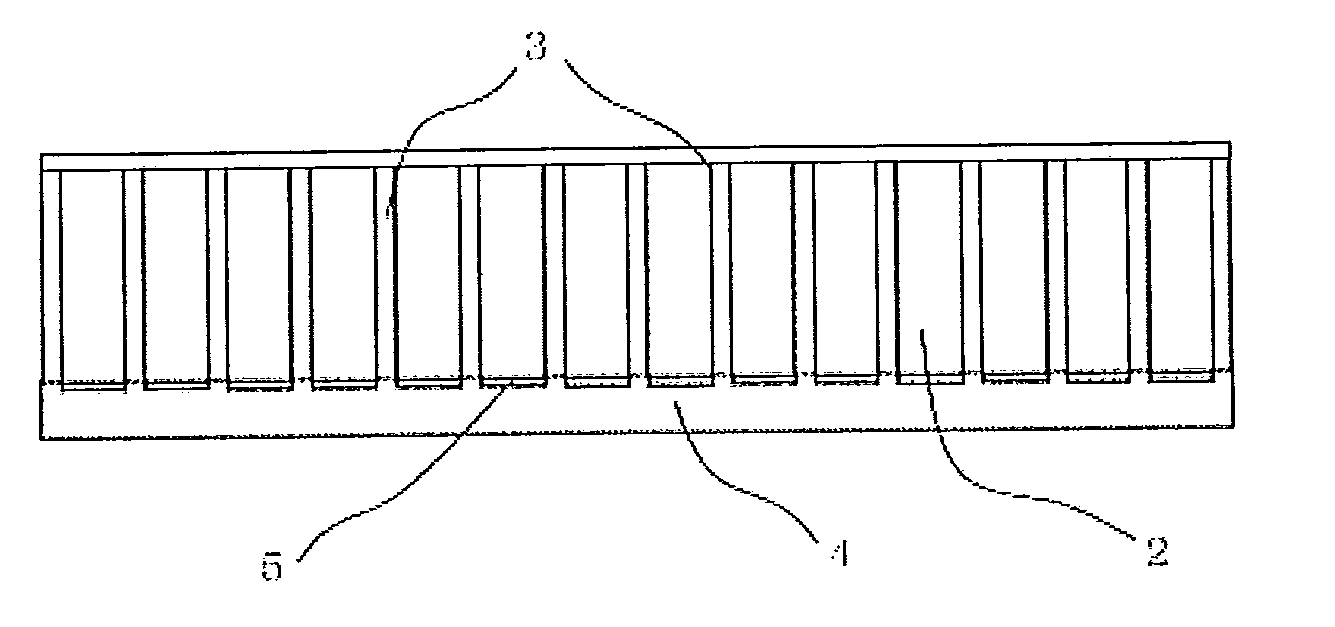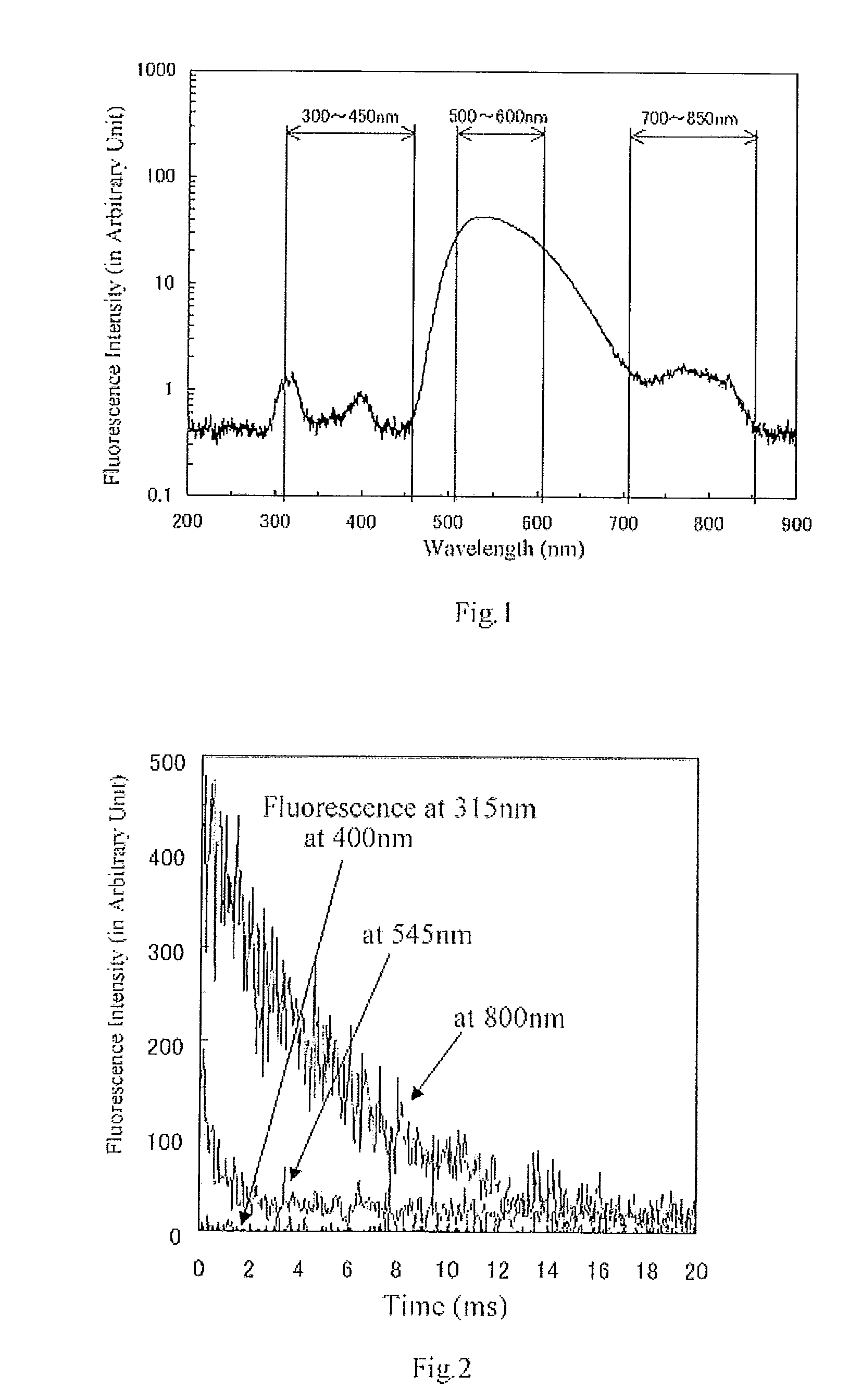Fluorescent material,scintillator using same, and radiation detector using same
a fluorescence material and scintillator technology, applied in the direction of fluorescence/phosphorescence, conversion screens, optical radiation measurement, etc., can solve the problems of reducing the use efficiency of x-rays, vibration from the exterior vibrating the electrode plate, and high internal pressure of the xenon gas filled chamber, so as to reduce the afterglow level and reduce the scan time. , the effect of increasing resolution
- Summary
- Abstract
- Description
- Claims
- Application Information
AI Technical Summary
Benefits of technology
Problems solved by technology
Method used
Image
Examples
first embodiment
[0100]A fluorescent material according to the first embodiment of the present invention comprises Ce as an activator and further comprises at least Gd, Al, Ga, O, Fe, and a component M, wherein the component M is at least one of Mg, Ti, Ni. The composition of the fluorescent material is expressed by the general formula:
(Gd1-x-zLuxCez)3+a(Al1-u-sGauScs)5−aO12
wherein
[0101]0≦a≦0.15,
[0102]0≦x≦0.5,
[0103]0.0003≦z≦0.0167,
[0104]0.2≦u≦0.6, and
[0105]0≦s≦0.1,
and wherein, regarding the concentrations of Fe and the component M,
[0106]0.05≦Fe concentration (mass ppm)≦1, and
[0107]0≦M concentration (mass ppm)≦50.
[0108]This material according to the present invention must contain Fe. The content of Si ranges from 0.05 to 1 mass ppm. FIG. 7 shows that when the content of Fe exceeds 1 mass ppm, this causes the 3 ms afterglow to exceed 800 ppm. Therefore, the after glow exceeds the tolerance level. This causes the upper limit of the content of Fe to be set at 1 mass ppm. However, the upper limit is pre...
second embodiment
[0143]A fluorescent material according to the second embodiment of the present invention contains Ce as a fluorescent activator. In addition, the material contains at least Gd, Al, Ga, and O. In addition, the material contains Lu and / or Y. The composition of the material is expressed by the following general formula.
(Gd1-x-zLxCez)3+a(Al1-uGau)5−aO12
wherein
[0144]L is Lu or Y,
[0145]0
[0146]0
[0147]0.0003≦z≦0.0167, (wherein x+z<1.0), and
[0148]0.2≦u≦0.6.
[0149]In addition, this fluorescent material has Fe added thereto. The weight ratio of Fe to Ce is not greater than 3%.
[0150]It is essential for this fluorescent material to contain Lu and / or Y. It is also essential for the composition of the material in a garnet structure to be deviated from the stoichiometric composition (a=0) so that 0<a. This means increasing excessively the amount of elements Gd, L, Ce in the C site (dodecahedral site) excessive, and decreasing accordingly the amount of elements Al and Ga in the A site...
third embodiment
[0165]In the thirds embodiment, the above fluorescent material is used as a scintillator. The third embodiment relates to a radiation detector having this scintillator and a light receiving element. This element is designed to detect fluorescent light emitted from the scintillator. This radiation detector is preferably mounted in a medical observation device or a medical inspection device such as an X-ray CT (Computed Tomography) scanner, a PET (Positron Emission Tomography) scanner, or a PET / CT scanner.
[0166]If the above material is used as a scintillator, the problems of a decreased X-ray sensitivity, of X-ray leakage, etc., may be solved. Thus, a high-sensitivity radiation detector may be obtained.
[0167]As shown in FIGS. 22 and 23, this radiation detector may be designed to include a scintillator and a photodetector. The detector serves to detect fluorescent light emitted from this fluorescent material. FIG. 22 is a schematic perspective view of a radiation detector. FIG. 23 is a...
PUM
| Property | Measurement | Unit |
|---|---|---|
| wavelength range | aaaaa | aaaaa |
| wavelength range | aaaaa | aaaaa |
| wavelength range | aaaaa | aaaaa |
Abstract
Description
Claims
Application Information
 Login to View More
Login to View More - R&D
- Intellectual Property
- Life Sciences
- Materials
- Tech Scout
- Unparalleled Data Quality
- Higher Quality Content
- 60% Fewer Hallucinations
Browse by: Latest US Patents, China's latest patents, Technical Efficacy Thesaurus, Application Domain, Technology Topic, Popular Technical Reports.
© 2025 PatSnap. All rights reserved.Legal|Privacy policy|Modern Slavery Act Transparency Statement|Sitemap|About US| Contact US: help@patsnap.com



